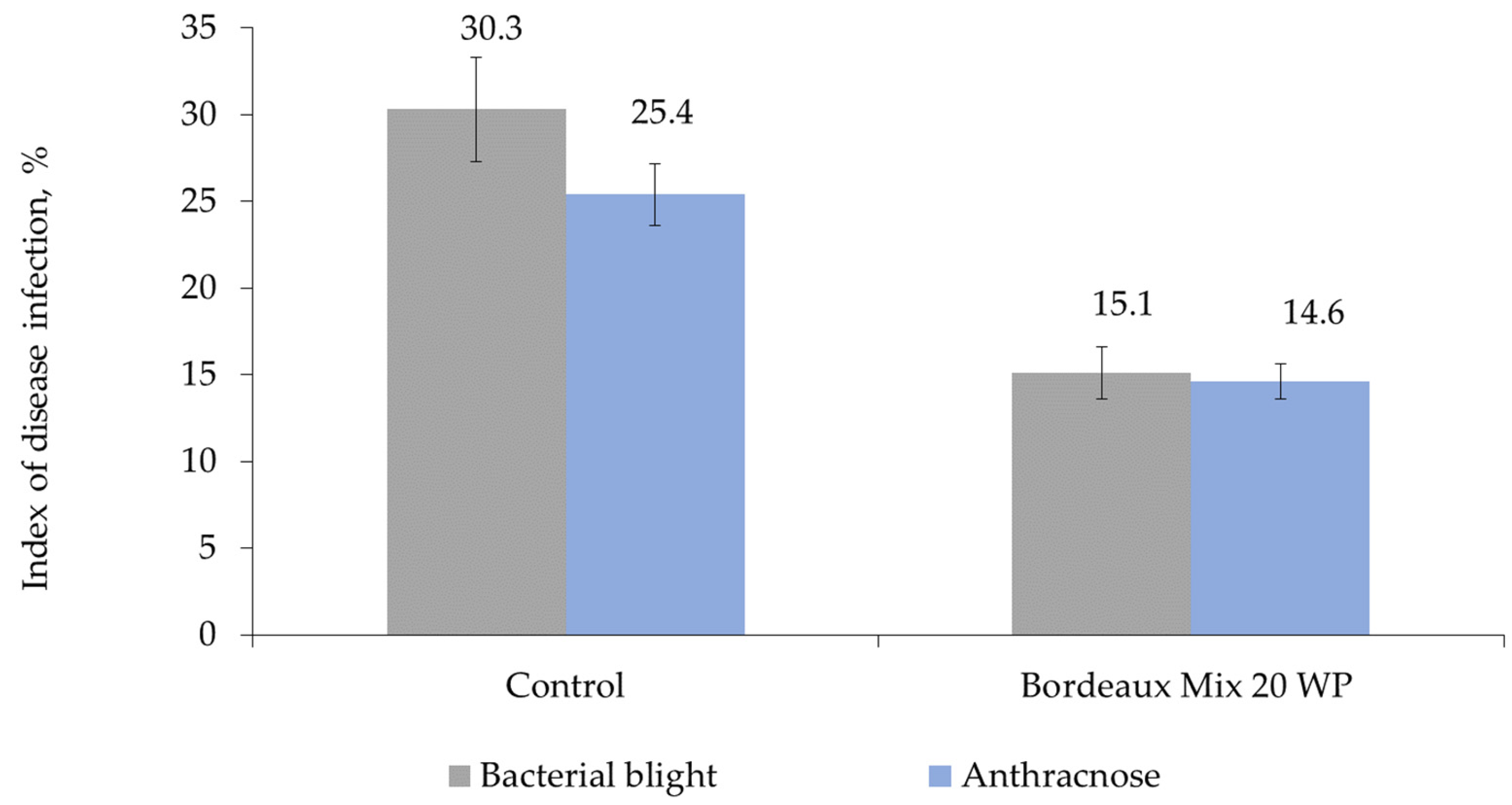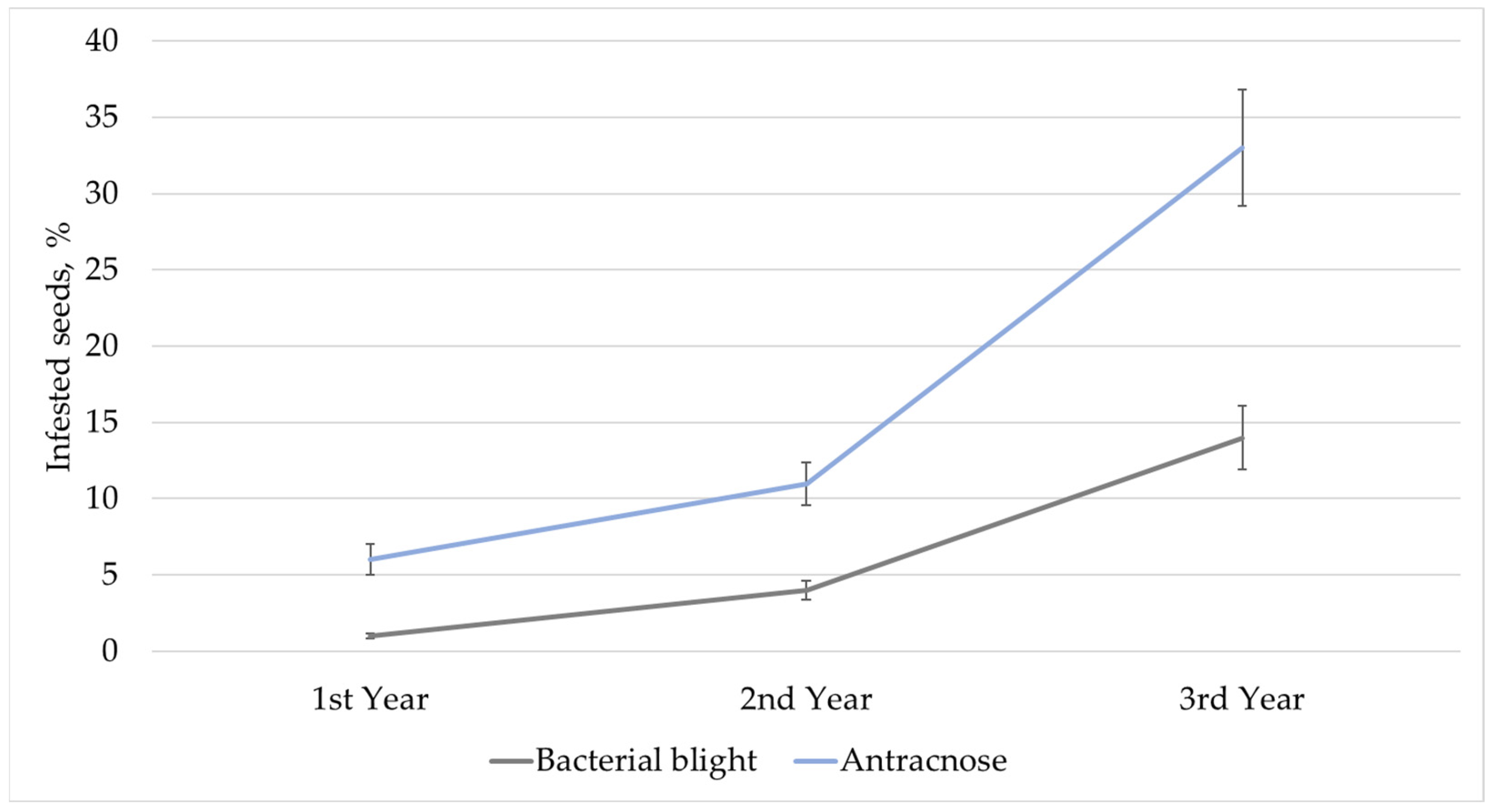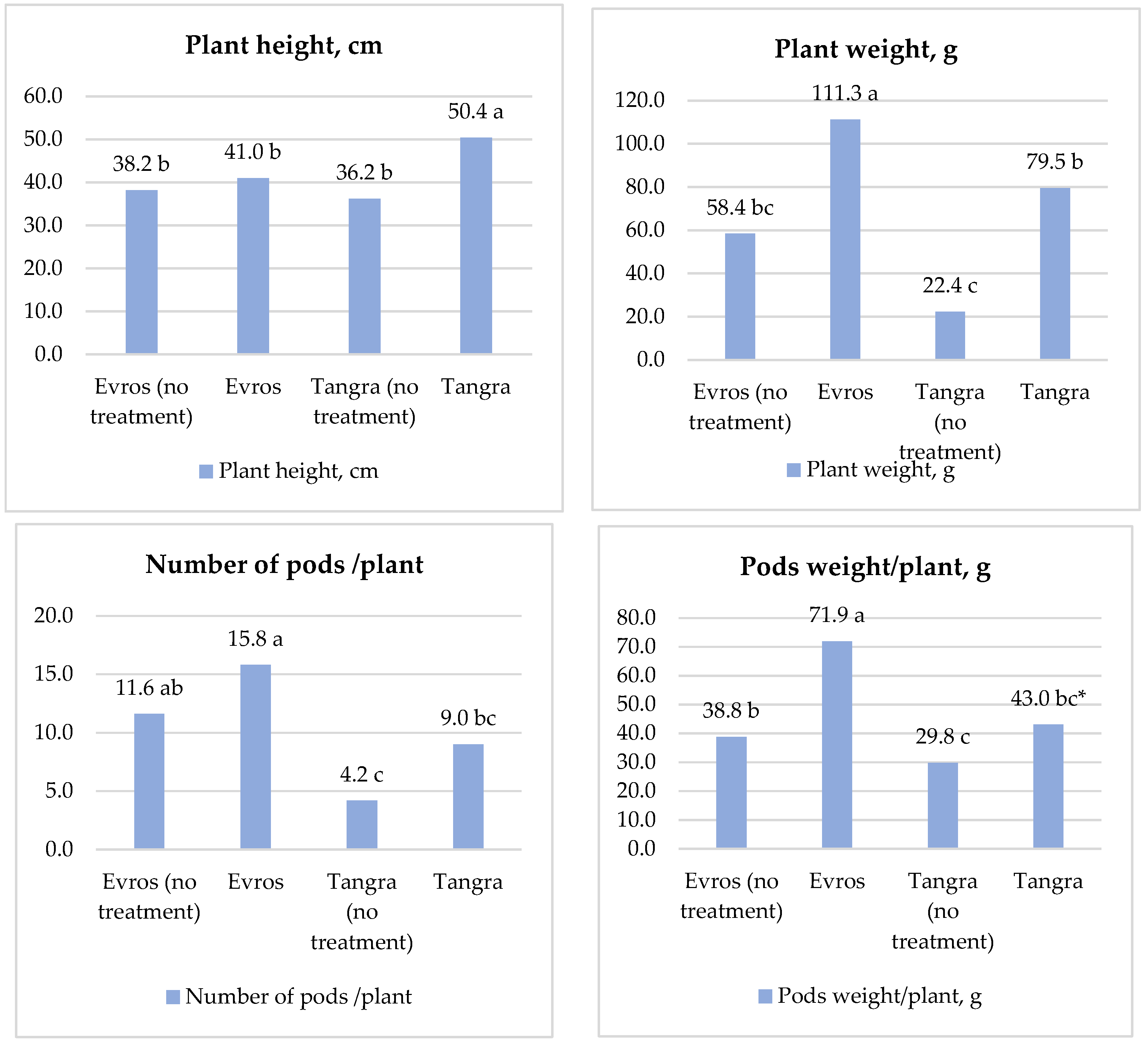Organic Production of Snap Bean in Bulgaria: Pests and Diseases Incidence and Control, Soil Fertility and Yield
Abstract
1. Introduction
2. Materials and Methods
2.1. Disease Monitoring and Management
2.2. Pests Monitoring and Management
2.2.1. Black Bean Aphid (Aphis fabae Scop.)
2.2.2. Bean Weevil (Acanthoscelides obtectus Say)
2.2.3. Two-Spotted Spider Mite (Tetranychus urticae Koch.)
2.3. Organic Fertilization and Soil Properties Assessment
2.4. Plant Growth and Productivity
2.5. Data Analyses
3. Results
3.1. Diseases
3.2. Pests
3.3. Monitoring Soil Nutrients
3.4. Plant Growth and Productivity
4. Discussion
5. Conclusions
Author Contributions
Funding
Institutional Review Board Statement
Informed Consent Statement
Data Availability Statement
Acknowledgments
Conflicts of Interest
References
- Ceritoglu, M.; Ceritoglu, F.; Erman, M.; Bektas, H. Root system variation of pulse crops at early vegetative stage. Not. Bot. Horti Agroboi. Cluj-Napoca 2020, 48, 2182–2197. [Google Scholar] [CrossRef]
- Ye, H.; Roorkiwal, M.; Valliyodan, B.; Zhou, L.; Chen, P.; Varshney, R.K.; Nguyen, H.T. Genetic diversity of root system architecture in response to drought stress in grain legumes. J. Exp. Bot. 2018, 69, 3267–3277. [Google Scholar] [CrossRef] [PubMed]
- Singh, A.; Chahal, H.S. Organic Grain Legumes in India: Potential Production Strategies, Perspective, and Relevance. In Legume Crops—Prospects, Production and Uses; Hasanuzzaman, M., Ed.; IntechOpen: London, UK, 2020; pp. 182–186. [Google Scholar] [CrossRef]
- Vauterin, L.; Rademaker, J.; Swings, J. Synopsis on the taxonomy of the genus Xanthomonas. Phytopathology 2000, 90, 677–682. [Google Scholar] [CrossRef] [PubMed]
- Bush, E. Anthracnose on Snap Beans. In Virginia Pest Management Guide for Home Grounds and Animals; Virginia Cooperative Extension: Blacksburg, VA, USA, 2009; pp. 450–719. [Google Scholar]
- Georgieva, O.; Sofkova-Bobcheva, S. Field screening of varieties of snap bean (Phaseolus vulgaris L.) for valuable economic traits and resistance to brown bacteriosis Xantomonas axanopodis pv. phaseoli (Smith). In Proceedings of the International Scientific and Practical Conference “Breeding for Resistance to Biotic and Abiotic Stressors in Vegetable Crops”, All-Russian Research Institute of Vegetable Breeding and Seed Production, Moscow, Russia, 11–13 August 2014; pp. 200–211. [Google Scholar]
- Darsonval, A.; Darrasse, A.; Durand, K.; Bureau, C.; Cesbron, S.; Jacques, M.A. Adhesion and fitness in the bean phyllosphere and transmission to seed of Xanthomonas fuscans subsp. fuscans. Mol. Plant Microbe Interact. 2009, 22, 747–757. [Google Scholar] [CrossRef] [PubMed]
- Georgieva, O.; Karadzhova, N. Common diseases of snap bean (Phaseolus vulgaris L.) for biological production. Agric. Sci. 2021, 13, 46–54. [Google Scholar] [CrossRef]
- Mohammed, A.; Ayalew, A.; Dechassa, N. Effect of integrated management of bean anthracnose (Colletotrichum lindemuthianum Sacc. and Magn.) through soil solarization and fungicide applications on epidemics of the disease and seed health in Hararghe Highlands, Ethiopia. J. Plant Pathol. Microbiol. 2013, 4, 182–189. [Google Scholar] [CrossRef]
- Shannag, H.K. Effect of black bean aphid, Aphis fabae, on transpiration, stomatal conductance and crude protein content of faba bean. Ann. Appl. Biol. 2007, 151, 183–188. [Google Scholar] [CrossRef]
- Purhematy, A.; Ahmadi, K.; Moshrefi, M. Toxicity of Thiacloprid and Fenvalerate on the black bean aphid, Aphis fabae, and biosafety against its parasitoid, Lysiphlebus fabarum. J. Biopest. 2013, 6, 207–210. [Google Scholar]
- Munyasa, A.J. Evaluation of Drought Tolerance Mechanisms in Mesoamerican Dry Bean Genotypes. Master’s Thesis, University of Nairobi, Nairobi, Kenya, September 2013. [Google Scholar]
- Schmale, I.; Wäckers, F.L.; Cardona, C.; Dorn, S. Field infestation of Phaseolus vulgaris by Acanthoscelides obtectus (Coleoptera: Bruchidae), parasitoid abundance, and consequences for storage pest control. Environ. Entomol. 2002, 31, 859–863. [Google Scholar] [CrossRef]
- Regnault-Roger, C.; Philogène, B.J.R. Past and current prospects for the use of botanicals and plant allelochemicals in Integrated Pest Management. Pharm. Biol. 2008, 46, 41–52. [Google Scholar] [CrossRef]
- Kleeberg, H. NeemAzal: Properties of a commercial Neem-seed-extract (Practice-oriented results on use and production of plant extracts and pheromones in integrated and biological pest control). In Proceedings of the 10th Workshop Dokki, Giza, Egypt, 10–11 February 2001. [Google Scholar]
- Isman, M.B. Botanical insecticides, deterrents, and repellents in modern agriculture and an increasingly regulated world. Annu. Rev. Entomol. 2006, 51, 45–66. [Google Scholar] [CrossRef]
- Hiiesaar, K.; Metspalu, L.; Jõgar, K.; Mänd, M.; Luik, A.; Švilponis, E. Influence of Neem-Azal T/S on feeding activity of Colorado Potato Beetles (Leptinotarsa decemlineata Say). Agron. Res. 2009, 7, 251–256. [Google Scholar]
- Shannag, H.S.; Capinera, J.L.; Freihat, N.M. Efficacy of different Neem-based biopesticides against green peach aphid, Myzus persicae (Hemiptera: Aphididae). Int. J. Agric. Pol. Res. 2014, 2, 61–68. [Google Scholar]
- Casida, J.; Quistad, G.B. Pyrethrum Flowers: Production, Chemistry, Toxicology and Uses, 1st ed.; Oxford University Press: Oxford, UK, 1995; p. 384. [Google Scholar]
- Isman, M.B. Botanical insecticides: A global perspective. In Biopesticides: State of the Art and Future Opportunities; Gross, A.D., Coats, J.R., Duke, S.O., Seiber, J.N., Eds.; American Chemical Society: Washington, DC, USA, 2014; Chapter 2; pp. 21–30. [Google Scholar] [CrossRef]
- Jababu, N.; Kofta, T.; Pokluda, R. Insecticidal activity of neem, pyrethrum and quassia extracts and their mixtures against diamondback moth larvae (Plutella xylostella L.). In MendelNet 2016—Proceedings of International PhD Students Conference; Polák, O., Cerkal, R., Belcredi, N.B., Horký, P., Vacek, P., Eds.; Mendel University: Brno, Czech Republic, 2016; pp. 84–89. [Google Scholar]
- Khater, H.F. Prospects of botanical biopesticides in insect pest management. Pharmacologia 2012, 3, 641–656. [Google Scholar] [CrossRef]
- Abdou, W.L.; Abdel-Hakim, E.A.; Metwally, H.M. Influence of entomopathogenic fungus Beauveria bassiana on the mortality, reproduction and enzyme activity of the aphid adults Aphis craccivora (Koch). Middle East J. Appl. Sci. 2017, 7, 567–573. [Google Scholar]
- Kim, J.J.; Jeong, G.; Han, J.H.; Lee, S. Biological control of aphid using fungal culture and culture filtrates of Beauveria bassiana. Mycobiology 2013, 41, 221–224. [Google Scholar] [CrossRef]
- Javed, K.; Javed, H.; Mukhtar, T.; Qiu, D. Efficacy of Beauveria bassiana and Verticillium lecanii for the management of whitefly and aphid. Pakistan J. Agric. Sci. 2019, 56, 669–674. [Google Scholar] [CrossRef]
- Mc Kinney, H.H. A new system of grading plant diseases. J. Agric. Res. 1923, 26, 195–218. [Google Scholar]
- Abbott, W.S. A method of computing the effectiveness of an insecticide. J. Econ. Entomol. 1925, 18, 265–267. [Google Scholar] [CrossRef]
- Henderson, C.F.; Tilton, E.W. Tests with acaricides against the brow wheat mite. J. Econ. Entomol. 1955, 48, 157–161. [Google Scholar] [CrossRef]
- Sonneveld, C. Estimating quantities of water-soluble nutrients using a specific 1:2 by volume extract. Soil Sci. Plant Anal. 1990, 21, 1257–1265. [Google Scholar] [CrossRef]
- Duncan, D.B. Multiple range and multiple F Tests. Biometrics 1955, 11, 1–42. [Google Scholar] [CrossRef]
- Yankova, V.; Markova, D.; Cholakov, T.; Sovkova, S. Effectiveness of products with active ingredient azadirachtin towards twospotted spider mite (Tetranychus urticae Koch.) in tomato and common bean for open field production. In Proceedings of the 4th International Symposium “Ecological Approaches towards the Production of Safety Food”, Plovdiv, Bulgaria, 9 June 2011. [Google Scholar]
- Pscheidt, J.W. Copper-based Bactericides and Fungicides. In Pacific Northwest Plant Disease Management Handbook; Oregon State University: Corvallis, OR, USA, 2022. [Google Scholar]
- Khalequzzaman, K.M. Management of Anthracnose of hyacinth bean for safe fresh food production. Asian J. Appl. Sci. Eng. 2015, 4, 102–109. [Google Scholar]
- Dechassa, N. Occurrence, distribution, biology and management of coffee thread blight (Corticium koleroga (Cke) Hoehnel): A Review. J. Environ. Earth Sci. 2019, 9, 1–6. [Google Scholar] [CrossRef]
- Pavela, R. Possibilities of botanical insecticide exploitation in plant protection. Pest Technol. 2007, 1, 47–52. [Google Scholar]
- Grzywacz, D.; Stevenson, P.C.; Mushobozi, W.L.; Belmain, S.; Wilson, K. The use of indigenous ecological resources for pest control in Africa. Food Secur. 2014, 6, 71–86. [Google Scholar] [CrossRef]
- Morgan, E.D. Azadirachtin, a scientific gold mine. Bioorg. Med. Chem. 2009, 17, 4096–4105. [Google Scholar] [CrossRef]
- Pavela, R. Effectiveness of some botanical insecticides against Spodoptera littoralis Boisduvala (Lepidoptera: Noctudiae), Myzus persicae Sulzer (Hemiptera: Aphididae) and Tetranychus urticae Koch (Acari: Tetranychidae). Plant Prot. Sci. 2009, 45, 161–167. [Google Scholar] [CrossRef]
- Kojima, T.; Yamato, S.; Kawamura, S. Natural and synthetic pyrethrins act as feeding deterrents against the Black Blowfly, Phormia regina (Meigen). Insects 2022, 13, 678. [Google Scholar] [CrossRef]
- Bayu, M.S.Y.I.; Prayogo, Y. Field efficacy of entomopathogenic fungi Beauveria bassiana (Balsamo.) for the management of mungbean insect pests. IOP Conf. Ser. Earth Environ. Sci. 2018, 102, 012032. [Google Scholar] [CrossRef]
- Wang, H.; Peng, H.; Li, W.; Cheng, P.; Gong, M. The toxins of Beauveria bassiana and the strategies to improve their virulence to insects. Front. Microbiol. 2021, 12, 705343. [Google Scholar] [CrossRef]
- Omar, Z.Z.; Rashid, T.S.; Awla, H.K. Influence of two varieties of broad bean and Beauveria bassiana (Blas) on Aphis fabae Scop. under field conditions. Polytech. J. 2019, 9, 16–19. [Google Scholar] [CrossRef]
- Međo, I.; Marčić, D.; Slobodan Milenković, S. Acaricidal and behavioral effects of azadirachtin on two-spotted spider mites (Acari: Tetranychidae). In 7th Congress on Plant Protection; Marčić, D., Glavendekić, M., Nicot, P., Eds.; Plant Protection Society of Serbia: Belgrade, Serbia, 2015; pp. 181–186. [Google Scholar]
- Dabrowski, Z.T.; Seredyńska, U. Characterisation of the two-spotted spider mite (Tetranychus urticae Koch., Acari: Tetranychidae) response to aqueous extracts from selected plant species. J. Plant Prot. Res. 2007, 47, 113–124. [Google Scholar]
- Venzon, M.; Togni, P.H.B.; Perez, A.L.; Oliveira, J.M. Control of two-spotted spider mites with neem-based products on a leafy vegetable. Crop Prot. 2020, 128, 105006. [Google Scholar] [CrossRef]
- Kleeberg, H. Neem based products: Registration requirements, regulatory processes and global implications. In Neem: Today and in the New Millennium; Koul, O., Wahab, S., Eds.; Springer: Dordrecht, The Netherlands, 2004; pp. 109–123. [Google Scholar] [CrossRef]
- Bernardi, D.; Botton, M.; da Cunha, U.S.; Bernardi, O.; Malausa, T.; Garcia, M.C.; Navae, D.E. Effects of azadirachtin on Tetranychus urticae (Acari: Tetranychidae) and its compatibility with predatory mites (Acari: Phytoseiidae) on strawberry. Pest Manag. Sci. 2013, 69, 75–80. [Google Scholar] [CrossRef]
- Tognetti, C.; Laos, F.; Mazzarino, M.J.; Hernandez, M.T. Composting vs. vermicomposting: A comparison of end product quality. Compost Sci. Util. 2005, 13, 6–13. [Google Scholar] [CrossRef]
- Lim, S.L.; Wu, T.Y.; Lim, P.N.; Shak, K.P.Y. The use of vermicompost in organic farming: Overview, effects on soil and economics. J. Sci. Food Agric. 2015, 95, 1143–1156. [Google Scholar] [CrossRef]



| Treatment | Bacterial Blight | Anthracnose | ||
|---|---|---|---|---|
| Infestation Index, % | Effect, % | Infestation Index, % | Effect, % | |
| Control | 30.3 a | - | 25.4 a | - |
| Bordeaux mixture | 11.3 a | 62.7 c | 7.7 b | 69.7 ab |
| Copper hydroxide | 12.3 a | 59.4 c | 7.3 b | 71.3 ab |
| Azoxystrobin and difenoconazole * | - | - | 5.8 c | 77.2 a |
| Penconazole ** | - | - | 12.5 c | 50.8 c* |
| Days after Treatment | Krisant EC 750 mL/ha | Naturalis 1000 mL/ha |
|---|---|---|
| 1 | 72.6 bc | 58.4 c |
| 3 | 85.8 a | 71.0 ab |
| 5 | 84.9 a | 74.5 ab |
| 7 | 80.1 a | 83.5 a |
| 10 | 70.7 bc | 75.6 ab |
| 14 | 60.6 c | 64.4 c* |
| Treatment/Variety | Total Number of Seeds | Infested Seeds | Index of Infestation, % | Effectiveness, % | |
|---|---|---|---|---|---|
| Number | % | ||||
| Krisant EC/Tangra | 452 | 10 | 2.2 | 1.1 | 77.1 ns |
| Krisant EC/Evros | 512 | 32 | 6.3 | 3.5 | 75.2 ns |
| Neem Azal/Tangra | 448 | 14 | 3.1 | 1.3 | 72.9 ns |
| Neem Azal/Evros | 506 | 39 | 7.7 | 3.7 | 73.7 ns* |
| Control/Tangra | 408 | 38 | 9.3 | 4.8 | - |
| Control/Evros | 447 | 114 | 25.5 | 14.1 | - |
| Days Post-Treatment | Population Status (Number of Living Individuals/Leaf) | Effectiveness, % | |||
|---|---|---|---|---|---|
| Control Pre-Treatment | Control Post-Treatment | Neem Azal T/S Pre-Treatment | Neem Azal T/S Post-Treatment | ||
| 1 | 35.3 a | 40.3 c | 41.5 a | 19.0 ab | 59.9 c |
| 3 | 35.3 a | 43.8 c | 41.5 a | 13.8 bc | 73.3 ab |
| 5 | 35.3 a | 49.0 bc | 41.5 a | 9.3 c | 84.0 a |
| 7 | 35.3 a | 52.3 ab | 41.5 a | 12.0 c | 80.5 a |
| 10 | 35.3 a | 54.8 a | 41.5 a | 16.8 b | 74.0 ab |
| 14 | 35.3 a | 59.5 a | 41.5 a | 24.0 ab | 65.7 c* |
| Sampling Date | Variety | pH | EC, mS/cm | N, mg/L | P, mg/L | K, mg/L | Ca, mg/L | Mg, mg/L |
|---|---|---|---|---|---|---|---|---|
| Mid-April | Before sowing | 6.55 ± 0.15 | 0.05 ± 0.01 | 10 ± 5 | 8.1 ± 2.3 | 13.3 ± 2.5 | 4.0 ± 1.5 | 9.6 ± 2.5 |
| End of April | Evros | 6.52 ± 0.12 | 0.04 ± 0.01 | 10 ± 7 | 1.8 ± 0.5 | 8.3 ± 1.5 | 4.0 ± 1.5 | 12.0 ± 2.8 |
| Tangra | 6.44 ± 0.11 | 0.04 ± 0.01 | 10 ± 8 | 2.9 ± 0.4 | 8.3 ± 1.2 | 4.0 ± 1.2 | 9.6 ± 2.2 | |
| Beginning of June | Evros | 5.76 ± 0.13 | 0.05 ± 0.02 | 0 ± 5 | 0.9 ± 0.1 | 5.0 ± 1.0 | 4.0 ± 1.3 | 7.2 ± 2.1 |
| Tangra | 5.60 ± 0.10 | 0.04 ± 0.01 | 0 ± 5 | 0.0 ± 0.3 | 5.0 ± 1.1 | 4.0 ± 1.5 | 7.2 ± 2.0 | |
| End of June | Evros | 7.20 ± 0.16 | 0.09 ± 0.02 | 25 ± 10 | 2.2 ± 0.3 | 13.3 ± 2.6 | 4.0 ± 1.5 | 12.0 ± 2.6 |
| Tangra | 7.14 ± 0.12 | 0.10 ± 0.03 | 25 ± 8 | 0.0 ± 0.8 | 13.3 ± 2.3 | 4.0 ± 1.1 | 9.6 ± 2.5 | |
| Beginning of August | Evros | 7.00 ± 0.06 | 0.10 ± 0.01 | 25 ± 5 | 1.6 ± 0.5 | 13.3 ± 2.4 | 4.0 ± 1.0 | 9.6 ± 2.3 |
| Tangra | 7.02 ± 0.10 | 0.11 ± 0.03 | 25 ± 5 | 1.4 ± 0.7 | 16.6 ± 2.6 | 4.0 ± 2.0 | 12.0 ± 2.5 |
| Varieties | Plant Height, cm | Plant Weight, g | Number of Pods/Plant | Pods Weight/Plant, g | Number of Seeds/Plant | Seeds Weight/Plant, g | Seed Yield, kg/da |
|---|---|---|---|---|---|---|---|
| Evros (no treatment) | 36.6 b | 3.9 c | 7.4 ns | 11.2 ns | 35.8 ab | 8.1 a | 161.0 a |
| Evros | 37.4 b | 6.3 b | 7.2 ns | 9.4 ns | 41.6 a | 8.9 a | 178.8 a |
| Tangra (no treatment) | 38.2 b | 2.9 c | 5.6 ns | 7.2 ns | 19.4 c | 4.4 b | 87.6 b |
| Tangra | 47.4 a | 9.1 a | 7.2 ns | 11.1 ns | 29.0 bc | 8.2 a | 164.6 a* |
Disclaimer/Publisher’s Note: The statements, opinions and data contained in all publications are solely those of the individual author(s) and contributor(s) and not of MDPI and/or the editor(s). MDPI and/or the editor(s) disclaim responsibility for any injury to people or property resulting from any ideas, methods, instructions or products referred to in the content. |
© 2023 by the authors. Licensee MDPI, Basel, Switzerland. This article is an open access article distributed under the terms and conditions of the Creative Commons Attribution (CC BY) license (https://creativecommons.org/licenses/by/4.0/).
Share and Cite
Yankova, V.; Georgieva, O.; Karadzhova, N.; Markova, D.; Kalapchieva, S.; Tringovska, I. Organic Production of Snap Bean in Bulgaria: Pests and Diseases Incidence and Control, Soil Fertility and Yield. Horticulturae 2023, 9, 90. https://doi.org/10.3390/horticulturae9010090
Yankova V, Georgieva O, Karadzhova N, Markova D, Kalapchieva S, Tringovska I. Organic Production of Snap Bean in Bulgaria: Pests and Diseases Incidence and Control, Soil Fertility and Yield. Horticulturae. 2023; 9(1):90. https://doi.org/10.3390/horticulturae9010090
Chicago/Turabian StyleYankova, Vinelina, Olga Georgieva, Nataliya Karadzhova, Dima Markova, Slavka Kalapchieva, and Ivanka Tringovska. 2023. "Organic Production of Snap Bean in Bulgaria: Pests and Diseases Incidence and Control, Soil Fertility and Yield" Horticulturae 9, no. 1: 90. https://doi.org/10.3390/horticulturae9010090
APA StyleYankova, V., Georgieva, O., Karadzhova, N., Markova, D., Kalapchieva, S., & Tringovska, I. (2023). Organic Production of Snap Bean in Bulgaria: Pests and Diseases Incidence and Control, Soil Fertility and Yield. Horticulturae, 9(1), 90. https://doi.org/10.3390/horticulturae9010090






